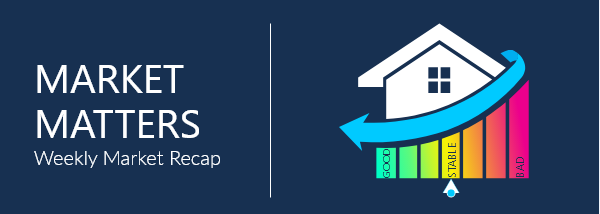Market Matters

More optimism on a “phase one” trade deal continues, while it’s been a busy couple of days on the data front with the holiday shortened week.
 Case-Shiller Housing Price Index
Case-Shiller Housing Price Index
The Case-Shiller 20-City index rose +.4% on the month, with August revised up to +.2% from an original posted -.2%. Within the report, we see 17 of 20 cities experience growth in September. The top performers were Seattle (+.8%), Los Angeles (+.7%), Phoenix, Tampa, and New York (+.6%). S&P notes that, "After a long period of decelerating price increases, it is notable that in September both national and 20-city rose at a higher rate than prior. It is too soon to say whether this month marks an end to deceleration or is merely a pause in longer term trend."
 New Homes Sales
New Homes Sales
New Homes Sales in October fell -.7% to a 733k unit selling rate, down from an upwardly revised 738k (original 701k) in the prior month. However, given the lower level, the 2-month trend is now the best since July 2007. The median new house price fell -3.5% to $316,700 in October from a year ago, while inventory remains tight at 5.3 months. Interesting fact that homes under $200k only accounted for 9% of sales in October. Finally, new home sales in the South, which accounts for the bulk of transactions, fell -3.3% in October, while sales in the Northeast were down -18.2%. Sales increased +4.2% in the Mid-West and jumped up +7.1% in the West.
 Pending Homes Sales
Pending Homes Sales
Pending Homes Sales (signed contracts) in October dropped by -1.7%, now posting a +4.4% increase YoY, according to the National Association of Realtors. Regionally, monthly sales in the Northeast rose +1.9% (+3% annually), the Midwest fell
-2.7% (+1.8% annually), the South down -1.7% (+5.1% annually), and the West fell by -3.4% (+7.5% annually). Lawrence Yun, chief economist at the NAR, noted that, “We still need to address, and more importantly, correct inadequate levels of inventory across the country. There is no shortage of buyers seeking homes, but a lack of available units continues to drag down the nation’s housing market and overall economy.”
 Q3 GDP
Q3 GDP
The first revision to Q3 GDP showed an increase to +2.1%, which is up from the advance estimate reported back on October 30th of +1.9%. The largest positive contribution came from a rise in inventories, which are now up $10.8bln. With Q1 at +3.1%, and Q2 at +2%, this now brings the YTD average around +2.4%, just slightly behind 2018’s +2.5% total. That said, economists are currently projecting below a +1% growth rate in Q4 this year, which would bring the total YTD average to 2% or lower.
 Consumer Spending/Income
Consumer Spending/Income
Consumer spending, which accounts for more than two-thirds of economic activity in the U.S., rose by +.3% in October. This is now the eighth straight month where spending has seen an increase. Last month, households spent more on electricity and gas, offsetting a drop in new motor vehicle purchases. Personal income was unchanged, held down by declines in interest income and farm income. With spending outpacing income growth, the savings rate fell to $1.29trl from a prior $1.34trl back in September. Finally, the PCE index, which is the Fed’s preferred measure of inflation, rose by +.2%, lifted by food and energy. If we strip out the food and energy components, we see a rise of only +.1% last month. This now lowers the annual increases in the core PCE to +1.6% in October from +1.7% in September.

